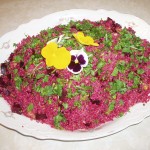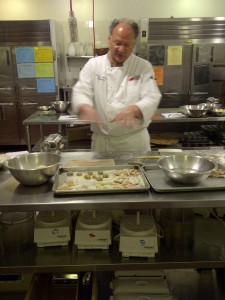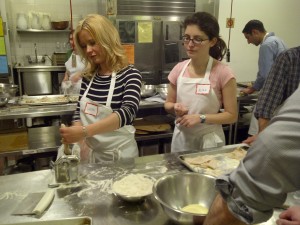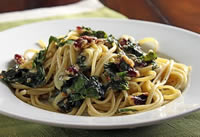I’m not hearing any buses yet, so I’m going to keep on writing!
Lately, Sherri and I have been working away at creating delicious Gluten-Free baked goods recipes (crackers, muffins, cookies, cakes, buns, breads) for our teaching kitchen and I realized this morning that this is a problem. These baked goods are for ‘occasional’ meals only. As a society we have relied heavily on them as the backbone and focus of our meals and snacks – to the detriment of our health. Instead of looking at ways of making gluten-free, sugar-free, dairy-free baked goods, let’s concentrate on foods that are really going to heal and nourish our bodies.
Turn the page to VEGETABLES!
We can make a healthy choice to focus instead on finding delicious ways to fill at least half of every plate we eat with vegetables. This is the foundation. There are endless combinations and permutations we can combine to make delicious smoothies, spreads (for cucumbers, celery, slices of raw turnip, sweet potatoes, celery root), salads, stir fry’s or roasted vegetables. And when we add fruit to the mix, the sky’s the limit!
My favourite guide is George Mateljan’s book (and website) The World’s Healthiest Foods. The world’s most nutrient-dense foods do not lie in the animal protein list – but fall instead in the Vegetables list! Surprised? Topping the list – spinach, swiss chard, crimini mushrooms and asparagus. Of a three column list, two of the columns include vegetables, fruit, beans and legumes, herbs and spices and nuts and seeds. Grains are near the bottom with dairy and eggs and poultry and lean meats. Fish and shellfish lie between the two groups.
So, for the next week, I’m going to change my focus and start learning about the wonderful tastes and vitality of healthy, nutrient-rich vegetables. In the morning, I enjoy whole grain granola (and I’ll give you the recipe in case you would like to try it) with home-made kefir topped with fresh fruit. I’m trying to get the kids to have a smoothie to take with them to school for breakfast, but am still perfecting that option. For lunch, I usually have a salad with the leftovers from dinner before, or in the winter a salad with some soup. But I’m going to experiment more with combining beans and vegetables probably with some grains like quinoa and buckwheat. As for dinner, vegetables steamed, stir-fried, roasted and drizzled with a little olive oil or flax oil and seasoned with herbs, along with some lean meat or fish seasoned with fresh herbs. If I need a sweet later on, I’ll have some fresh fruit with a little more granola or sprinkled with flax seeds.
I’ll be honest, usually about 9:30 we have a “cup of tea” as a family which usually includes a cookie. Maybe this is the ‘occasion’. How many cookies or baked goods per week is the “right” amount? From my years of yo-yo dieting and bulimia, the one thing that I do KNOW is that once I put restrictions on the food that I am allowed to eat, I crave that restricted food. So I cannot answer that question. I think that the answer is different for each of us. But I do think – and will research this over the coming weeks – that if I fill my body with healthy, nutritious vegetables and fruits, I may not want a cookie or sweet at night.
I’ll be fully nourished.
Interesting thought!
Sautéed Asparagus
1 lb of asparagus, bottom twiggy section snapped off and the rest cut into 2 inch sections
3 Tbsp of vegetable broth
Heat the broth in a skillet over medium heat. Once it starts to steam, add the asparagus. Cover and cook for 5 minutes. Transfer to a bowl and toss with the Dressing for the buckwheat below.
Pan-Fried Perch
1 lb of fresh perch
2 Tbsp olive oil
2 Tbsp vegetable broth
2 cloves garlic, minced
Heat the broth and olive oil under medium heat, add the minced garlic and sauté for 2 minutes. Add the perch skin side down and cover. Fry for 3 – 5 minutes until the meat looks white and flakey. Remove from heat and serve.
Buckwheat Salad with Chick Peas, Cucumber, Tomatoes and Fresh Parsley
1 cup buckwheat (I used Kasha or toasted buckwheat)
2 cups water
1/2 tsp sea salt
½ can chick peas, drained and rinsed
½ English cucumber, small cubes
½ red onion, halved and thinly sliced
handful small grape tomatoes, halved
handful chopped fresh parsley
Dressing (make up and save as an easy salad dressing)
1/2 cup extra virgin olive oil
1/3 cup fresh lemon juice
zest of lemon
4 cloves garlic
Sea salt and pepper to taste
Cook the buckwheat – put first three ingredients together in pot and cover. Bring to a boil for a minute, then turn down to low and simmer for 10 – 12 minutes. Buckwheat is fully cooked when it is dry and fluffy. Do not stir the buckwheat while it is cooking.
Press garlic and let sit for 5 minutes (allows the health-promoting nutrient allicin to form). Whisk together with olive oil, lemon juice, garlic, salt and pepper.
Toss the buckwheat with the vegetables and chopped parsley and dress to taste. Serve on a bed of lettuce or spinach.
I’m going to add a photograph once I’ve got it all put together. New experience!





